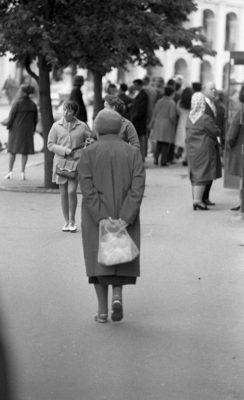 Militia detectives are at Kazansky Station in Komsomol Square, in Martin Cruz Smith’s novel Gorky Park. Cartier-Bresson’s 1954 photo shows the station at the left and surrounding traffic. Moscow prostitution may not have existed officially in 1977, when the story takes place, but sex work certainly did.
Militia detectives are at Kazansky Station in Komsomol Square, in Martin Cruz Smith’s novel Gorky Park. Cartier-Bresson’s 1954 photo shows the station at the left and surrounding traffic. Moscow prostitution may not have existed officially in 1977, when the story takes place, but sex work certainly did.
At 6 am entire Turkman families lay head to feet on benches. Babies with felt skullcaps nestled on soft bundles. Soldiers leaned slackly against the wall in a sleep so tangibly deep that the heroic mosaics of the ceiling overhead could have been their communal dream. Bronze fixtures glowed fully. At the one refreshment stand open, a girl in a rabbit-skin coat confided in Pasha Pavlovich…
A young soldier took Pasha’s place with the girl. She smiled through a rouge of vaseline and lipstick while the boy read the price chalked on the toe of her shoe; then, hand in hand, they walked out the station’s main door… Komsomol Square was blue before the dawn, the clicking candles of trams the only movement. The lovemakers slipped into a taxi. ‘Five rubles.’ Pasha watched the taxi pull out.
The driver would swing into the nearest side street and get out to watch for militia while the girl and boy went at it in the back seat. Of the five rubles the driver would get half and the chance to sell a congratulatory bottle of vodka to the soldier afterward; the vodka was a lot more expensive than the girl. The girl would get some sips, too. Then a return to the station, a tip to the washroom attendant for a fast douche, and overheated and giddy, she’d start all over. By definition prostitutes did not exist, because prostitution has been eliminated by the Revolution. Charges could be brought against them for spreading venereal disease, performing depraved acts or leading a nonproductive life, but by law there were no whores. – Gorky Park, 1981, p 151
 Note there was no street uniform to indicate which women were selling sex: anyone in photos from the period could have been. The shoe marking was new to me. A website purporting to cover ‘sex in the Soviet Union‘ (before 1992) goes on about such identifying marks:
Note there was no street uniform to indicate which women were selling sex: anyone in photos from the period could have been. The shoe marking was new to me. A website purporting to cover ‘sex in the Soviet Union‘ (before 1992) goes on about such identifying marks:
Prostitutes waited on the platforms of large suburban train stations. They sat with their legs stretched out and their prices written on the soles of their shoes, so that any passerby could check it out. There were two price levels for prostitutes in Moscow: either three or five rubles.
The girls usually could be found near the Prospect Mira subway station. They wore rings made of three-ruble or five-ruble bills. One was green, the other was blue, and it was easy to tell the price the girls were asking.
Prostitution politics are symbolic rather than functional: the laws as written do not ever reflect the presence, absence or predominance of commercial sex. This means looking at sex work’s mores (or habitus) can reveal much more. You learn more from good portrayals in fiction than from rote news items. Gorky Park is a perfect example of a book not about prostitution in which sex workers and clients express agency in the face of the law. Another way to think about this is what I call the Cultural Study of Commercial Sex. In this case, a culture of prohibition, secrecy and resistance through codes is shown: perfectly apt for Soviet times.
-Laura Agustín, the Naked Anthropologist
